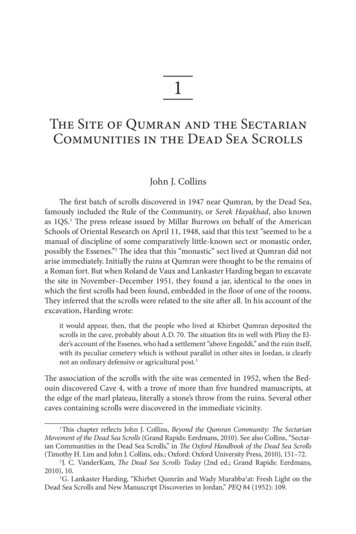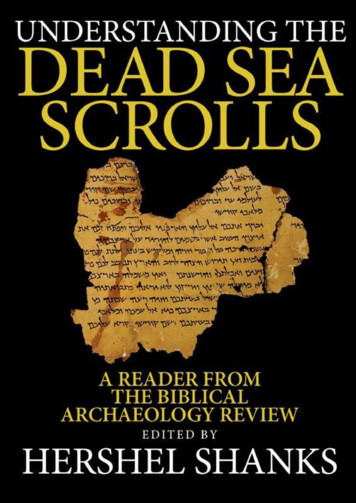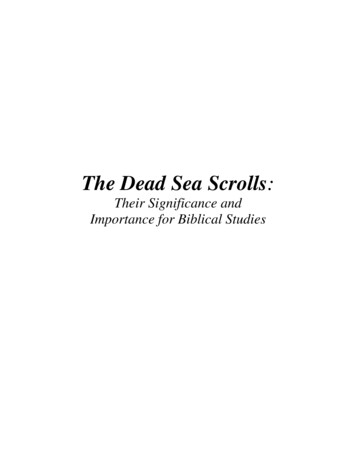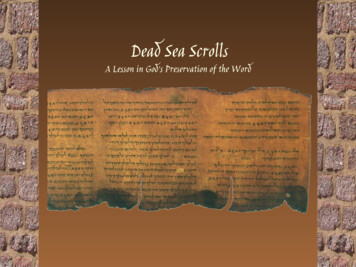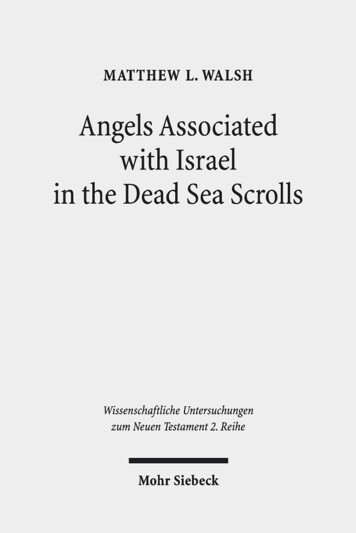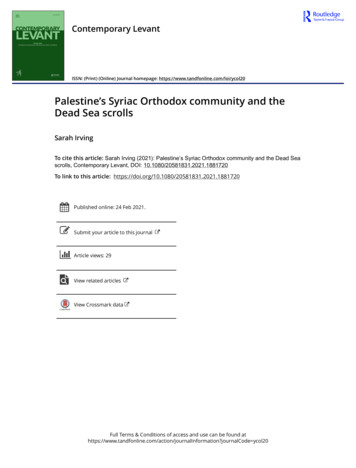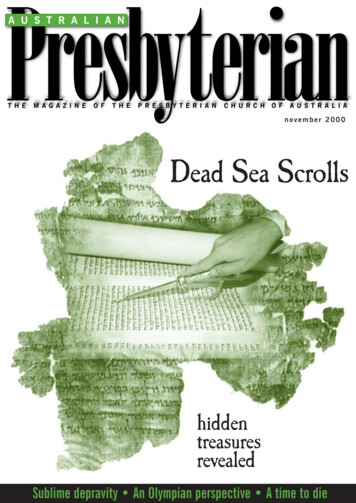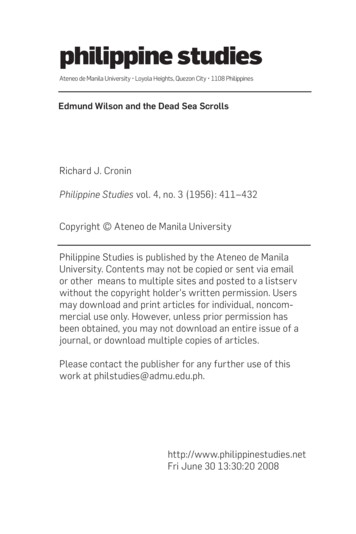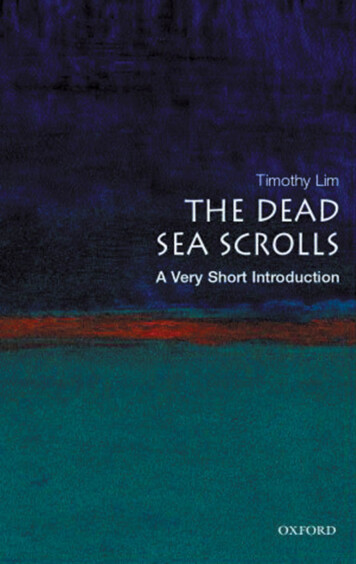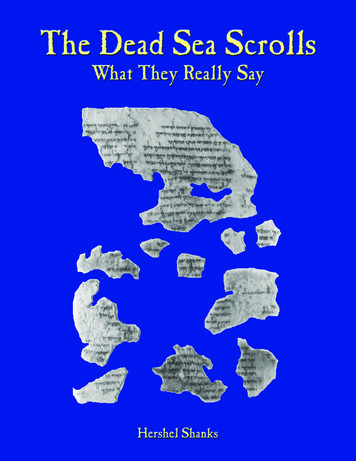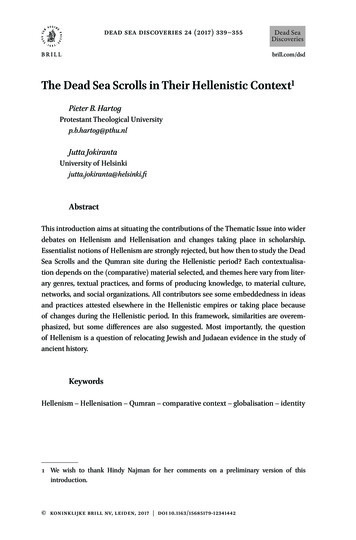
Transcription
DEAD SEA SCROLLS HISTORICAL INVESTIGATION LESSONObjective:Students will use images of the Dead Sea Scrolls to examine how historians piece together thepast and the importance of artifacts to learning about human history.Standards: CCSS.ELA- ‐‑Literacy.WHST.6- ‐‑8.1 Write arguments focused on discipline- ‐‑specific content. CCSS.ELA- ‐‑Literacy.WHST.6- ‐‑8.1a Introduce claim(s) about a topic or issue,acknowledge and distinguish the claim(s) from alternate or opposing claims, andorganize the reasons and evidence logically. CCSS.ELA- ‐‑Literacy.WHST.6- ‐‑8.1b Support claim(s) with logical reasoning andrelevant, accurate data and evidence that demonstrate an understanding of the topicor text, using credible sources. CCSS.ELA- ‐‑Literacy.WHST.6- ‐‑8.1c Use words, phrases, and clauses to create cohesionand clarify the relationships among claim(s), counterclaims, reasons, and evidence. CCSS.ELA- ‐‑Literacy.RH.6- ‐‑8.7 Integrate visual information (e.g., in charts, graphs,photographs, videos, or maps) with other information in print and digital texts.Materials: Copies of activities #1- ‐‑4Time:One class period (45- ‐‑60 minutes), plus homeworkProcedures: Divide students into groups of 3 or 4, based on your preference (ability, random, kids’choice, etc). This activity works well in any format Give each group a copy of activity #1. Allow approximately 10 minutes for the group tocomplete the questions. It may be helpful to have multiple copies of the image per group. Debrief the entire class about their observations. Encourage one student from each groupto report back on their thoughts. Pass out activity #2 to each group, and again allow about 10 minutes for it to be completed.Repeat the report- ‐‑out, choosing a different student to speak if possible. Distribute activity #3 to each group, and grant students a final 10 minutes to complete thequestions. Ask a third student from each group to share their observations with the classin a final report- ‐‑out session. For homework, have each student complete the reflection (activity #4). Begin the following class having students write their best suggestion for future research onthe Dead Sea Scrolls on the board, on post- ‐‑its that are added to a board, or on aninteractive bulletin board or chat room such as Padlet.com or TodaysMeet.com
Activity #1: A Historic TreasureDeep in a cave, explorers found the following parchment:With your group members, ponder the following: What is it? What language do you think it’s written in? How old do you think it is? What do we know about the people who made it?
ACTIVITY #2: A FORGOTTEN CIVILIZATIONBelow you find an image of the cave where the historical parchment was found, and amap of the region.With your group members, ponderthe following: Does seeing the location changeyour answers to any of thequestions from activity #1? Ifso, how? Can you predict whatinformation might be containedon the parchment based onwhere it was found? How might this discoverychange our view of history?
ACTIVITY #3: TRANSLATION AND REVELATIONThe discovered parchment, written in Hebrew, was read and discovered to be a veryearly version of the Book of Isaiah, one of the Old Testament texts. It was dated to 125BCE. Here is the text, translated to English, on the left along with a more commontranslation of the Book of Isaiah on the right.With your group members, ponder the following: Are the two translations similar? Different? How so? Before this parchment was discovered, the oldest copy of the Book of Isaiah was fromthe Codex Leningrad, from about 1000 CE. What does it tell us that this edition, 1100years older, is so similar? How did the discovery of this parchment (part of a treasure trove known as the DeadSea Scrolls) affect our view of history?
ACTIVITY #4: REFLECTIONThe Dead Sea Scrolls were a remarkable discovery. They contained the oldest versionsof several Old Testament (Hebrew Bible) books as well as records about the lives of theJewish inhabitants of the region. However, they also left many unanswered questions: Whywere they hidden in the caves? Who wrote them? How did they survive for nearly twomillennia undiscovered?In today’s activities, you acted like a historian, slowly revealing the story of the scrollsas you learned more information. In your reflection, you will continue this task. How wouldyou learn more about the Dead Sea Scrolls and the people who made them? (that’s yourclaim) Consider written sources you may consult, artifacts you might examine, or peopleyou may interview (that’s your evidence). You don’t need to actually find these sources, onlyexplain how you would do so. (eg, you can say you would visit a museum with Hebrewartifacts, you don’t actually have to go to the museum).Your 250 word reflection should be thoughtful and show an understanding of howhistorians learn about the past. Please use proper writing conventions, include words andphrases you have learned about the study of history, type and double space your response.Your score will be based on the following:ApproachingMeets StandardExceeding StandardStandardClaimStudent is able toStudent is able toStudent is able toidentify one way toidentify multipleidentify multiple,learn more about the ways to learn morediverse ways to learnDead Sea Scrollsabout the Dead Seaabout the Dead SeaScrollsScrollsSupport for ClaimStudent providesStudent provides aStudent providesvague examples tofew specific examples multiple thoroughsupport claimto support claimexamples to supportclaimWriting Conventions Several errors areNo more than aNo errors arepresentcouple of errors areapparentpresentHistoricalWord choice is basic Word choice isWord choice isVocabularygrade- ‐‑appropriateadvanced
Works Cited"English Translations of the Book of Isaiah." Digital Dead Sea Scrolls. Israel Museum, 2013. Web. 04Nov. 2013. http://dss.collections.imj.org.il/chapters pg ."The Great Isaiah Scroll." Digital Dead Sea Scrolls. The Israel Museum, 2013. Web. 04 Nov. 2013. http://dss.collections.imj.org.il/isaiah ."Map of the Dead Sea Region." Map. Dead Sea Scrolls. Library of Congress, 27 July 2010. Web. 4Nov. 2013. if .Schick, Alexander. Cave 11. Digital image. Discovery Sites. The Leon Levy Dead Sea Scrolls DigitalLibrary, n.d. Web. 4 Nov. 2013. 1.jpg .
Dead Sea Scrolls Lesson Plan Author: Center for Middle Eastern Studies - Outreach Center Created Date: 3/5/2014 3:58:42 PM .
